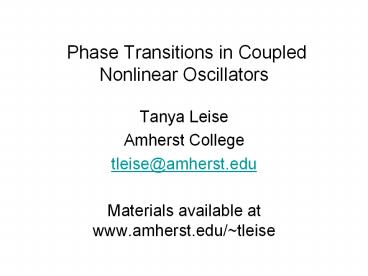Phase Transitions in Coupled Nonlinear Oscillators - PowerPoint PPT Presentation
1 / 23
Title:
Phase Transitions in Coupled Nonlinear Oscillators
Description:
Left hand. Right hand. Right hand. Left hand. Phase portrait: Bimanual Oscillations. Left hand ... of phase transitions in human hand movements. Biol. Cybern. ... – PowerPoint PPT presentation
Number of Views:211
Avg rating:3.0/5.0
Title: Phase Transitions in Coupled Nonlinear Oscillators
1
Phase Transitions in Coupled Nonlinear
Oscillators
- Tanya Leise
- Amherst College
- tleise_at_amherst.edu
- Materials available at www.amherst.edu/tleise
2
Single Finger Oscillation
3
Single Finger Oscillation
4
Bimanual Oscillations
Left hand Right hand
Right hand
Phase portrait
Left hand
5
Bimanual Oscillations
Right hand
Left hand Right hand
Left hand
Right hand
Left hand
6
Bimanual Oscillations
- Increasing frequency
In-phase
Out-of-phase
Transition
7
Basic Features
- Only two stable states exist in-phase and
out-of-phase. - As the frequency passes a critical value,
out-of-phase oscillation abruptly changes to
in-phase. - Beyond this critical frequency, only in-phase
motion is possible.
8
Developing a Model
- Goals
- To develop a minimal model that can reproduce
these qualitative features - To gain insight into underlying neuromuscular
system (how both flexibility and stability can be
achieved) - Nature uses only the longest threads to weave
her pattern, so each small piece of the fabric
reveals the organization of the entire tapestry. - ?R.P. Feynman
9
Developing a Model
- Control parameter
- Frequency w of oscillation (1-6 Hz divide by 2?
for radians/sec) - Variables (describing oscillations)
- Relative phase f of fingers (0º or 180º)
- Amplitude r of finger motion (0-2 inches)
10
Differential equation models
..
..
.
..
.
11
Nonlinear Oscillator
- Include nonlinear damping term(s) to yield
desired phase shifts as ? increases - Obtain self-sustaining oscillations if use
negative linear damping term - Hybrid oscillator (Van der Pol/Rayleigh)
- Seek stable oscillatory solution of form
..
.
.
.
12
Single Finger Oscillatory Solution
.
.
.
.
.
.
.
.
..
13
Single Finger Oscillatory Solution
..
.
.
.
.
.
.
.
.
.
14
Single Finger Oscillatory Solution
.
.
.
.
.
.
.
15
Coupled Nonlinear Oscillators
..
.
.
.
.
.
..
.
.
.
.
.
16
Bimanual Oscillatory Solutions
.
.
.
.
.
.
.
.
17
Bimanual Oscillatory Solutions
18
Stability Analysis
.
.
.
.
.
.
.
.
.
19
Loss of Stability Leads to Phase Transition
- Stability of the out-of-phase motion depends on
the sign of the eigenvalue - Increasing frequency ? beyond a critical value
?cr leads to change in stability of out-of-phase
motion, triggering switch to in-phase motion
.
20
Energy Well Analogy
.
- Potential function V(?) defined via
- Minima of V correspond to stable phases
- Maxima of V correspond to unstable phases
.
21
An Energy Well Model
Slow twiddling frequency
Fast twiddling frequency
22
Basic Twiddling Model
Potential function V for phase difference f
Stable states correspond to energy wells (minima
of V)
Conclusion f0 is always a stable state (minimum
for any a and b), while fp is a stable state
only for parameter values B/Agt1/4.
23
Sources
- H. Haken, J.A.S. Kelso, and H. Bunz. A
theoretical model of phase transitions in human
hand movements. Biol. Cybern., 51347-356, 1985. - A.S. Kelso, G. Schöner, J.P. Scholz, and H.
Haken. Phase-locked modes, phase transitions and
component oscillators in biological motion.
Physica Scripta, 3579-87, 1987. - B.A. Kay, J.A.S. Kelso, E.L. Saltzman, and G.
Schöner. Space-Time Behavior of Single and
Bimanual Rhythmical Movements Data and Limit
Cycle Model. Journal of Experimental Psychology
Human Perception and Performance, 13(2)178-192,
1987.































